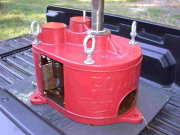Abe Swan (Monticello, Florida)
A three-day fall celebration, beginning the Tuesday before Thanksgiving, takes place on Abe Swan’s property. Mr. Swan noted that this property has been in his family since 1857, as recorded in the Jefferson County Courthouse. It is therefore special to family, as well as family friends, and attracts about 150 people from all over. Since I visited on Tuesday, I counted myself lucky to be part of the pre-shindig shindig.
_(88)_Wesley_Hollis_Chatt_13-t1.jpg) Slide 1 shows Wesley Hollis,
my contact for this operation, feeding the Chattanooga No. 13. Mr. Swan moved this mill to its present working
position about ten years ago; the old family mill, a Chattanooga No. 12, was
nearby.
Slide 1 shows Wesley Hollis,
my contact for this operation, feeding the Chattanooga No. 13. Mr. Swan moved this mill to its present working
position about ten years ago; the old family mill, a Chattanooga No. 12, was
nearby.
Note the greens in the background. In North Florida, greens usually survive all winter. I let my sister’s birthday, December 29th, be my reminder to plant turnips and mustard.
A family friend, Dot, takes over
the skimming chore (Slide
2). Note
_(44)_Dot_skimming-t.jpg) the very massive furnace that this
80-gallon Rourke kettle sits in.
Construction debris is the energy source. An outer rim simply serves to increase the
kettle’s capacity. However,
they do not use an inner ring, but instead simply skim from the top of the
boiling juice. Without the inner
ring, they do not bring the syrup to an unruly boil. This method of cooking in a kettle without the
ring is unusual, though not unique.
the very massive furnace that this
80-gallon Rourke kettle sits in.
Construction debris is the energy source. An outer rim simply serves to increase the
kettle’s capacity. However,
they do not use an inner ring, but instead simply skim from the top of the
boiling juice. Without the inner
ring, they do not bring the syrup to an unruly boil. This method of cooking in a kettle without the
ring is unusual, though not unique.
Rochelle Swan (left, Slide 3), Abe’s brother, is the chief cook and supervisor of cooking. I had the good fortune to have his chicken, which was just excellent. Later on, he roasted a whole pig, which puts the size of this syrup-making frolic in perspective!
A cypress syrup trough (Slide 4), in this case, 100-years old, identifies this operation as authentic. As recently as the mid 1900s, these troughs were common and found service in a variety of ways, such as feeding and watering hogs.
In the background, chicken pens dominate the view. There are few things that provide a better root to a homestead than a chicken coop.






_(73)_Rochelle_Swan-t.jpg)
_(88)_trough-t.jpg)